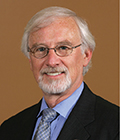
Stephen C. Crane
An interview with Stephen C. Crane, PhD, MPH, ATS Executive Director
Q: Can you explain the increase in young attendees at the International Conference?
A: Over the past several years, ATS presidents have identified the next generation of clinicians and researchers as imperative to the Society and the fields of pulmonary, critical care, and sleep medicine. We found that barriers of entry include time and cost of education, so our organization has made a concentrated effort on preparing early career professionals.
This has led to the creation of our tremendously popular education offerings, including the Fellows Track Symposium and Resident Boot Camp, which focus on the knowledge it takes to be a clinician and/or researcher as well as the skills that it takes to survive a fellowship. We are also reaching back even further with our Student Scholars program to attract medical, graduate, nursing, physician assistants, and respiratory therapy students to the field by offering them mentorship during the conference.
This year, we had so many applications to these programs that we needed to increase capacity, and we are now accommodating 405 early career professionals. This represents a 61 percent increase in enrollment from last year.
Our support doesn’t end on the last day of the conference. It continues year-round through the Career Development Center at thoracic.org. Our interactions with younger members also continue through our social media channels, which include Facebook, LinkedIn, Twitter, and now Instagram.
Q: ATS 2015 features more pedagogical programs than before. What spurred growth in this area?
A: Cutbacks in research funding and pressures on universities to generate revenue are requiring more of those in our fields to take on clinical faculty and teaching roles. We have identified as a priority the need to improve the ability of those who are going to be teaching others in both didactic and clinical settings. During ATS 2015, we’re providing medical educators with more opportunities to hone their teaching skills and navigate careers in academia.
The new ATS Section on Medical Education, which was established under the ATS Assembly on Behavioral Science and Health Services Research (BSHSR), is hosting Medical Education Seminars. These three seminars provide insights and techniques to improve effectiveness in teaching across health care disciplines, age groups, and learning venues. These sold out just about as soon as registration was available.
We also have the Faculty Development Seminars, which were created by the ATS Members in Transition and Training Committee. Since its introduction last year, the series has grown from two to three sessions that cover competing for, negotiating, and keeping academic jobs. The series quickly filled as soon as registration was available as well. And these topics are also expanded upon in workshops that take place in the Center for Career Development here at ATS 2015.
Our programs are varied, but they all focus on a central theme of developing the next generation of clinicians and researchers.
Q: How do the ATS’s advocacy efforts distinguish it from other organizations?
A: When members and others think about what our Washington, D.C., efforts focus upon, their immediate thoughts go to our advocating for the development of new treatments for patients, supporting programs that finance the delivery of care for all, and our calling for increased investment in research funding.
Our advocacy efforts do not stop with research and clinical care. Equally important to the ATS is preventing the problems that we research and treat from occurring in the first place. On the issue of prevention, the ATS has an active role. For example, we are the scientific backstop for the Environmental Protection Agency on all of its work on clean air. We also look at regulations in the workplace to assure the safety of workers from airborne carcinogens and other irritants, and we continue to push for strict regulations on e-cigarettes while research continues.
A key part of our networking on the policy front has been our continued visits with National Institutes of Health leaders by our Executive Committee as well as our very successful Hill Day activities, where individuals come from several committees and lobby members and staffs of Congress.
Having made those connections—whether a formal meeting or a simple hello in the hallways on the hill—is invaluable when problems arise and we need to reach out for legislative help. We’ve been greatly encouraged by the people who make the Hill Day visits and want to return the following year, so we’re exploring new ways of expanding our efforts and including younger members.
These combined efforts contribute to the principle mission of the ATS, which is to move the needle on global lung morbidity and mortality.
